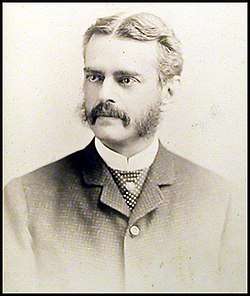William G. Binney
William Greene Binney (October 22, 1833 – August 3, 1909)[2] was an American malacologist, working mostly during the second half of the nineteenth century. He was responsible for volumes 4 and 5 of The Terrestrial Air-Breathing Mollusks of the United States [3] ,[4] a task he took over from his father, Amos Binney, and collaborator, Augustus Addison Gould. The ninety engraved plates which were part of volume 5, illustrating most of the then known land mollusk fauna, are particularly noteworthy.
William G. Binney | |
|---|---|
 William G. Binney | |
| Born | William Greene Binney October 22, 1833 |
| Died | October 22, 1909 (aged 76) |
| Nationality | American |
| Alma mater | Harvard University |
| Spouse(s) | Marie Louise Chamberlain[1] |
| Scientific career | |
| Fields | Malacology, Conchology |
Binney's obituary in the New York Times, included the following information:[5]
Mr. Binney followed in the steps of his father, who was an authority on molluscs. Besides editing his father's works, he prepared for the Smithsonian Institution a work on "The Land and Fresh Water Shells of America" and numerous monographs on the same subject. He was also responsible, in conjunction with Amos Binney, for the collection of North American shells at the Harvard Museum.
Bibliography
- The terrestrial air-breathing mollusks of the United States, and the adjacent territories of North America
References
- Henry P. Binney Family Papers
- William Greene Binney
- Binney, William G. 1859. The Terrestrial Air-Breathing Mollusks of the United States. Vol. 4. Boston MA: The Boston Journal of Natural History.
- Binney, William G. 1878. The Terrestrial Air-Breathing Mollusks of the United States. Vol. 5. Cambridge MA: Harvard College Museum of Comparative Zoology.
- https://timesmachine.nytimes.com/timesmachine/1909/08/04/106721077.pdf W. G. Binney obituary in 4 August 1909 The New York Times p.7